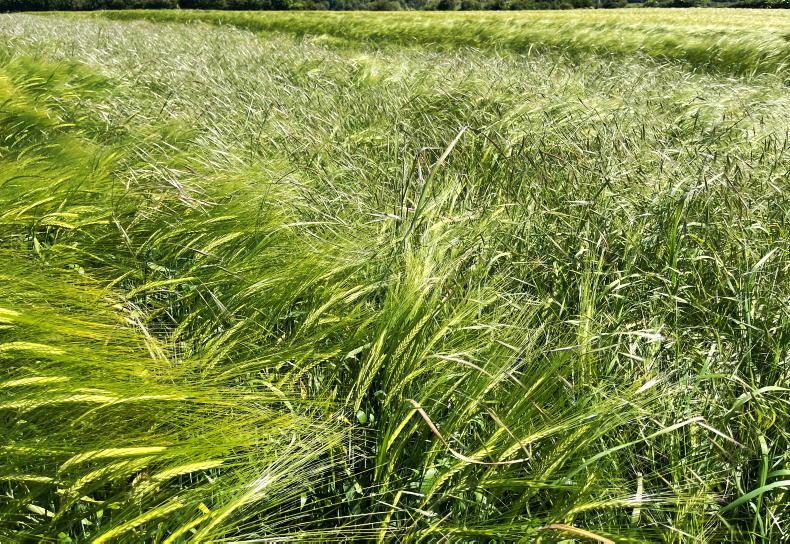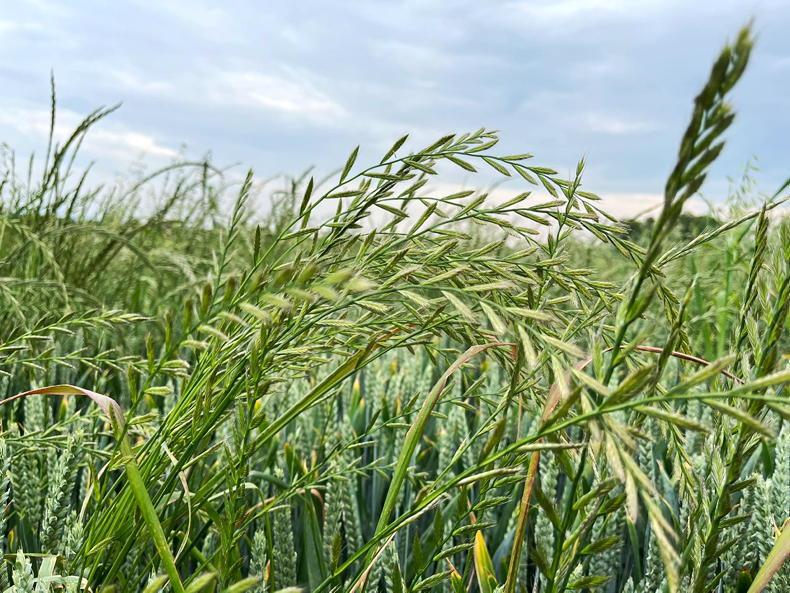Grass weeds are now visible in many tillage fields. Most of these grass weeds can return incredible numbers of seeds to re-infect your land. It is crucial to plan and implement integrated weed management (IWM) strategies to prevent such infestations from becoming detrimental, yield-robbing and costly to control.
Weed management decisions
Weed management decisions at this time of year can be divided into three areas:
Pre-harvest – rogueing, spraying off, wholecropping.Harvest – machinery hygiene.Post-harvest – stale seedbed timing, strategic ploughing, crop species to grow based on weed control achieved this season, delayed drilling of autumn cereals, use of non-cereal break crops, herbicide options, spring cropping, etc.It is now time for pre-harvest weed control. This includes:
Walking your crops to identify grass-weeds that are present correctly. Marking the weed patches on a map for future reference and inspecting field margins. Using each and every opportunity to stop seed set, by hand-rogueing or spot spraying for small infestations or by taking more drastic action like whole cropping or spraying off for heavy infestations.If you have found blackgrass for the first time on your farm, determine the reason it got there (eg machinery, rented land, etc). In most cases, a zero-tolerance approach, including drastic measures is necessary.If you have large uncontrolled weeds in your crops or you suspect resistance, it is really a good idea to collect seed samples for a free herbicide resistance test to find out the best herbicides/modes of action for immediate control of your populations.This article provides pictures to help with grass weed identification and should help growers and advisers to correctly and confidently identify grass weeds and plan the right integrated weed management strategy.
Figure 1 shows the things you need to look out for in flowering grass weeds: (A) seed heads, (B) the ligule (little transparent membrane found between the base of the leaf and stem) and (C) leaves in the shoot.

Figure 1 shows the things you need to look out for in flowering grass weeds.
What to look for when identifying flowering grass weeds
Structure and appearance of the seed heads.Size and shape of the ligule (little transparent membrane found between the base of the leaf and stem).Whether leaves are rolled or flat in shoot.
Sterile brome: open drooping panicle. Hairless or only minutely hairy main axis of panicle. Ligule is medium (2mm to 4mm) and serrated. Leaves rolled in shoot.

Soft brome: compact heads. Usually hairy spikelets. Mature spikelets have tight packing of seeds. Saucer shaped mature seed cross-section. Leaf blade and leaf sheath are very hairy. Ligule is short (2mm), blunt, hairy and serrated. Leaves rolled in shoot.

Annual meadow-grass: open-branched and spreading seed heads. Ligule is medium (2-5mm), roundly pointed and serrated. Leaves flat in shoot.

Lesser canary grass: long, dense spike heads. Ligule is medium to long (3-8mm) and pointed. Leaves rolled in shoot. The root tip has a distinct red sap.
Correct identification of grass weeds will enable post-harvest IWM actions, especially for brome grasses.With harvest coming up, ensure machinery hygiene to prevent field-to-field seed transfer.If you have even a small-to-modest population of bromes in your crop this season, be very cautious. Avoid winter barley or winter oats in these fields next season as there is a lack of effective chemical control options for bromes in these crops.Drastic measures must be adopted in fields found with blackgrass and Italian ryegrass. Our research indicates that small-to-modest populations of these two critical species do not necessarily reduce resistance risk.
Vijaya Baskar.

Blackgrass: compact spike (slender) heads. Ligule is medium (2-4mm), blunt and serrated. Leaves rolled in shoot.

Great brome: open, dropping panicle. Distinctly hairy main axis of panicle. Ligule is medium to long (3-6mm), rounded and jagged. Leaves rolled in shoot.

Wild oats: loose drooping panicle. Pale green in colour. Awns present. Fine hairs present along leaf margin and leaf sheath. Ligule is long (6mm to 8mm) and rounded. Leaves rolled in shoot.
Grass weeds are now visible in many tillage fields. Most of these grass weeds can return incredible numbers of seeds to re-infect your land. It is crucial to plan and implement integrated weed management (IWM) strategies to prevent such infestations from becoming detrimental, yield-robbing and costly to control.
Weed management decisions
Weed management decisions at this time of year can be divided into three areas:
Pre-harvest – rogueing, spraying off, wholecropping.Harvest – machinery hygiene.Post-harvest – stale seedbed timing, strategic ploughing, crop species to grow based on weed control achieved this season, delayed drilling of autumn cereals, use of non-cereal break crops, herbicide options, spring cropping, etc.It is now time for pre-harvest weed control. This includes:
Walking your crops to identify grass-weeds that are present correctly. Marking the weed patches on a map for future reference and inspecting field margins. Using each and every opportunity to stop seed set, by hand-rogueing or spot spraying for small infestations or by taking more drastic action like whole cropping or spraying off for heavy infestations.If you have found blackgrass for the first time on your farm, determine the reason it got there (eg machinery, rented land, etc). In most cases, a zero-tolerance approach, including drastic measures is necessary.If you have large uncontrolled weeds in your crops or you suspect resistance, it is really a good idea to collect seed samples for a free herbicide resistance test to find out the best herbicides/modes of action for immediate control of your populations.This article provides pictures to help with grass weed identification and should help growers and advisers to correctly and confidently identify grass weeds and plan the right integrated weed management strategy.
Figure 1 shows the things you need to look out for in flowering grass weeds: (A) seed heads, (B) the ligule (little transparent membrane found between the base of the leaf and stem) and (C) leaves in the shoot.

Figure 1 shows the things you need to look out for in flowering grass weeds.
What to look for when identifying flowering grass weeds
Structure and appearance of the seed heads.Size and shape of the ligule (little transparent membrane found between the base of the leaf and stem).Whether leaves are rolled or flat in shoot.
Sterile brome: open drooping panicle. Hairless or only minutely hairy main axis of panicle. Ligule is medium (2mm to 4mm) and serrated. Leaves rolled in shoot.

Soft brome: compact heads. Usually hairy spikelets. Mature spikelets have tight packing of seeds. Saucer shaped mature seed cross-section. Leaf blade and leaf sheath are very hairy. Ligule is short (2mm), blunt, hairy and serrated. Leaves rolled in shoot.

Annual meadow-grass: open-branched and spreading seed heads. Ligule is medium (2-5mm), roundly pointed and serrated. Leaves flat in shoot.

Lesser canary grass: long, dense spike heads. Ligule is medium to long (3-8mm) and pointed. Leaves rolled in shoot. The root tip has a distinct red sap.
Correct identification of grass weeds will enable post-harvest IWM actions, especially for brome grasses.With harvest coming up, ensure machinery hygiene to prevent field-to-field seed transfer.If you have even a small-to-modest population of bromes in your crop this season, be very cautious. Avoid winter barley or winter oats in these fields next season as there is a lack of effective chemical control options for bromes in these crops.Drastic measures must be adopted in fields found with blackgrass and Italian ryegrass. Our research indicates that small-to-modest populations of these two critical species do not necessarily reduce resistance risk.
Vijaya Baskar.

Blackgrass: compact spike (slender) heads. Ligule is medium (2-4mm), blunt and serrated. Leaves rolled in shoot.

Great brome: open, dropping panicle. Distinctly hairy main axis of panicle. Ligule is medium to long (3-6mm), rounded and jagged. Leaves rolled in shoot.

Wild oats: loose drooping panicle. Pale green in colour. Awns present. Fine hairs present along leaf margin and leaf sheath. Ligule is long (6mm to 8mm) and rounded. Leaves rolled in shoot.















 This is a subscriber-only article
This is a subscriber-only article










SHARING OPTIONS: